All 13 Types of Bird Nests (With 30+ Species Examples)
Birds are some of the most ingenious creatures on the planet. It is astonishing to consider some of the structures built by animals who use only their beaks and claws. Nest specifications vary greatly by species and depend on factors such as materials available, predators and the weather. Regardless, one simple necessity remains the same: the nest must provide each bird with a safe and secure environment to incubate their eggs and raise their young. So without further ado, here are the 13 ingenious ways birds build their nests.

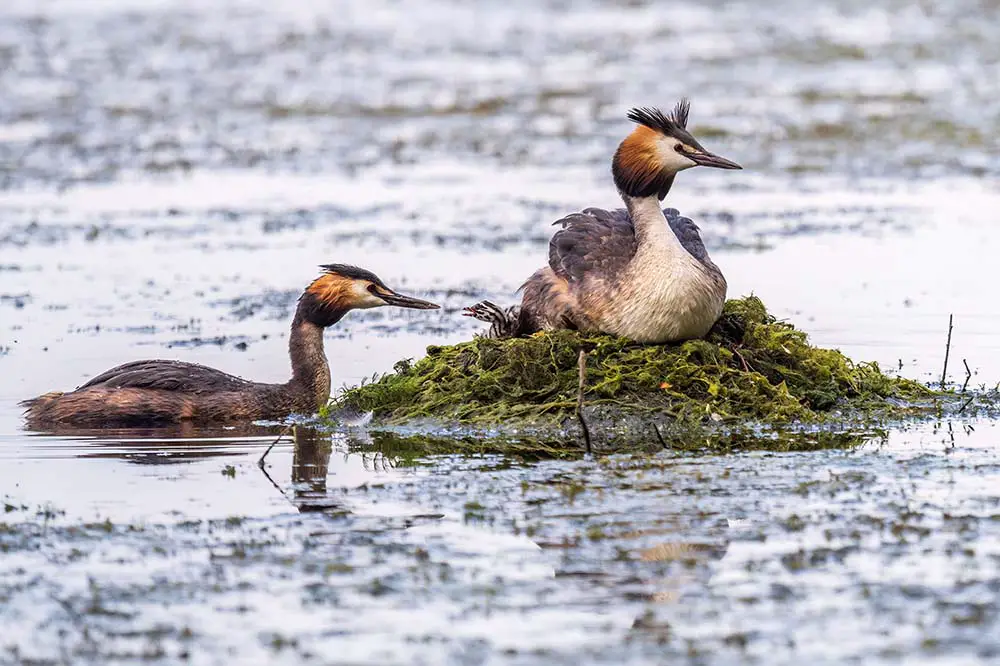
Left: American flamingo with their eggs / Shutterstock & Right: Great crested grebes with their nest / Shutterstock
Contents
- Standard Cup
- Adherent Cup
- Dome / Sphere
- Pendant
- Colonial
- Cavity
- Platform
- Floating
- Burrow
- Mound
- Self-incubating
- Scrape
- No Nest
- Honourable Mention
Standard Cup
The cup is arguably the quintessential bird’s nest. They are woven with soft, pliable materials such as grasses and twigs and feature a deep depression in the centre to house the eggs or young.
At just 1-2 inches in diameter, hummingbird nests are the smallest and some of the most visually impressive, often camouflaged with chips of lichen and bark. The nests of broad-tailed hummingbirds are built by females in around 4 to 5 days and are bound together with spider webs. This is also the case for Anna’s hummingbirds who use the soft fluff from cattails to construct theirs.
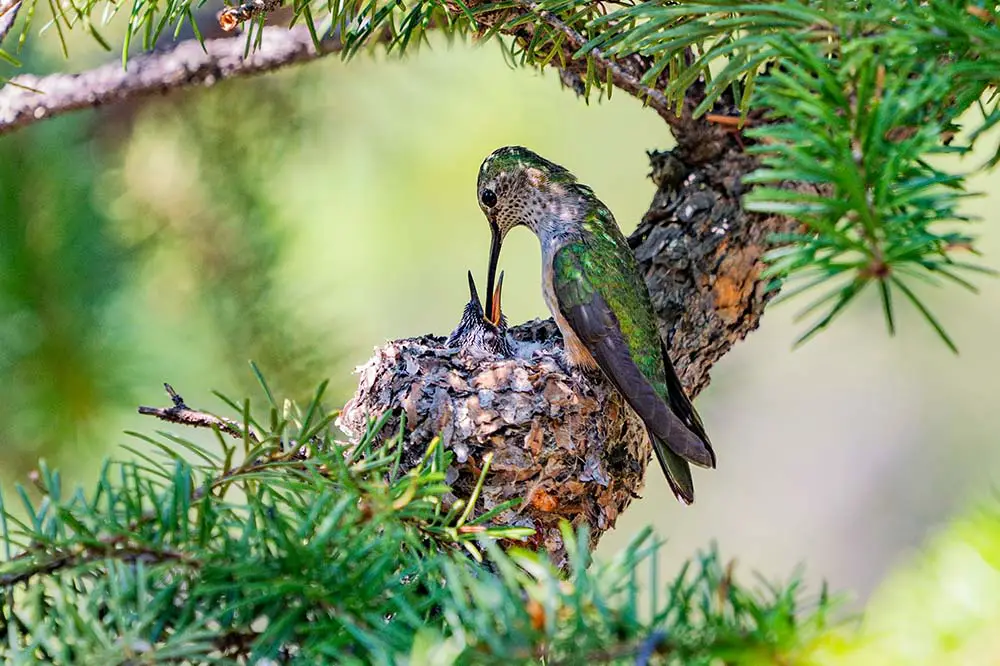
Cup nests are used frequently by passerine birds. The American robin is a great example and a type of bird whose young are referred to as altricial, those who are born underdeveloped and rely on their parents to nurture them. This is in contrast to precocial young, which we’ll cover later on.
The black-hooded oriole has a particularly interesting variation of the cup nest; instead of resting on top of branches, this species uses a hanging cup, which is woven by the females in 3 to 6 days.

Adherent Cup
A slight variation on the standard cup is those that adhere to walls. These nests are similar in shape but their construction varies considerably.
The most famous of these adherent nests are those of the white-nest swiftlet also known as the edible nest swiftlet. These nests are constructed by the males of the species over a period of around 35 days and are made entirely of the bird’s saliva, which dries to form a hard cement-like material. These nests are considered a delicacy in some countries, where they are used to make soup.

The barn swallow also adheres its nest to walls but, perhaps wisely, uses mud as a construction material, which is not a popular soup ingredient. Nests are built by both males and females over a period of around two weeks and can take hundreds of trips during construction. Once the mud structure is complete, the nest is lined with soft materials such as grasses and feathers.
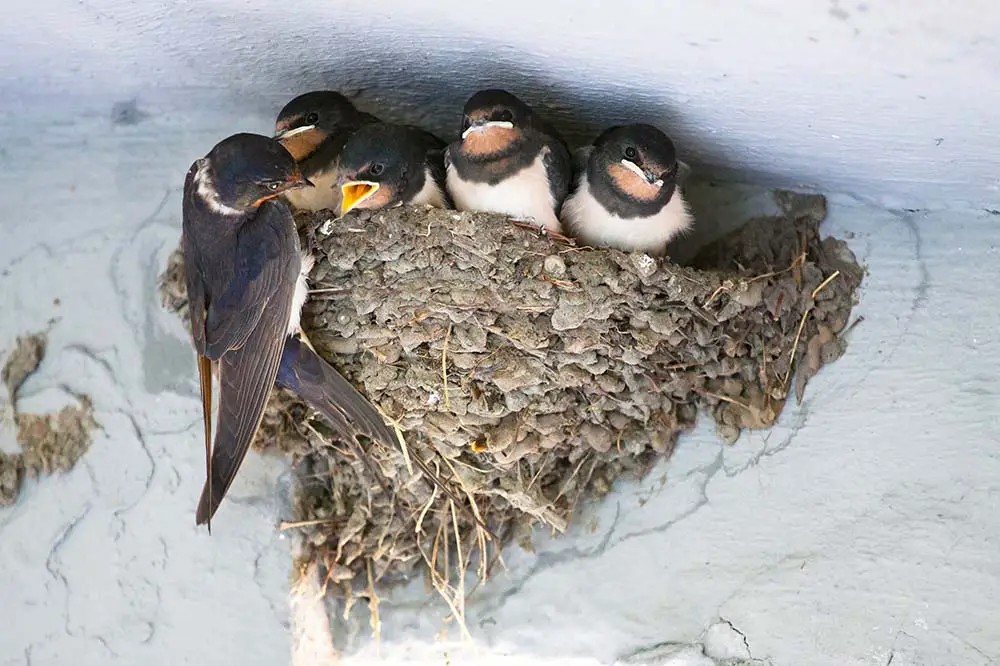
Dome / Sphere
Unlike a cup nest, which is exposed to the elements, dome or sphere nests can be crafted from a wide range of materials and are fully enclosed, offering a greater amount of protection.
One of the most impressive domes is that of the ovenbird, also known as the Rufous hornero. This species begins construction by creating a cup and then continues to mould thousands of mud pellets eventually creating a neat oven-shaped nest, hence the name, with a slit at the front and soft bedding inside. The entire process takes about 2 weeks.

It’s not just mud that is used to create dome nests. Birds such as the white-throated dipper create their domes from soft vegetation such as moss and grass. These birds are water specialists and position their nests next to streams or rivers where they hunt aquatic insects and worms.
Africa’s hamerkop bird is also no stranger to the water and is famous for its gigantic dome-shaped nests, which take up to 6 weeks to construct and can measure almost 5 ft (4’ 11” / 1.5 m) in diameter.

Pendant
Pendant nests are also fully enclosed but are suspended from trees and make for some of the most intricate structures. Advantages include increased protection from predation although they are more susceptible to the wind.
One particularly interesting design is that of the Eurasian penduline tit who construct theirs with a tube-shaped opening at the top. These nests are built by both sexes over a period of 2-3 weeks and are made from soft plant fibres, wool and grasses.

Montezuma oropendolas live in polygynous colonies where a dominant male performs most of the copulation. The females of this species build the nests, which are found in groups of up to 100 and have a particularly long shape when compared to some of the other pendant nests.
Some of the most well-known pendant-building birds are the members of the weaver family. The male baya weaver builds its nest in several stages; the “helmet” takes around 8 days to construct at which point they advertise it to the females. Once paired, the entrance tunnel is added and the nest is completed in a total of 18 days.
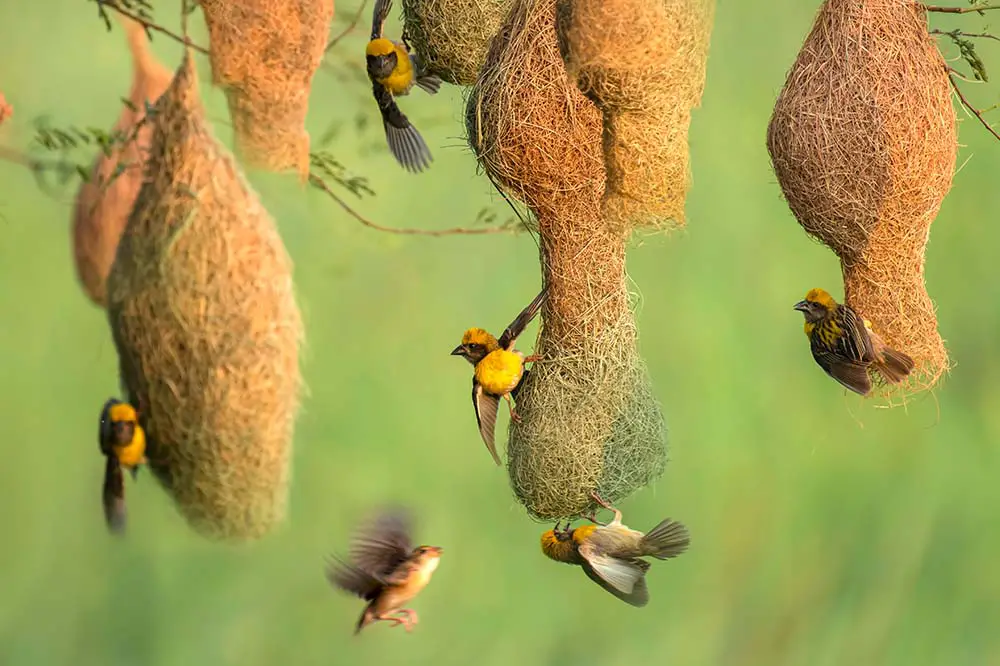
Colonial
There are many species of bird that nest together in colonies but the vast majority of them have separate nests. Colonial nests that host multiple mating pairs are rare but are some of the most impressive.
Sociable weavers are found in Southern Africa and have perhaps the most unique nest on this entire list. These gigantic structures are made from sticks and dry grasses and are built in trees or sometimes utility poles and can house upwards of 400 – 500 birds. Like the nests of the baya weaver, entrances are located at the bottom of the nest where its inhabitants can enter one of the many chambers within. Although these nests are perched in trees to avoid predation, they are not totally immune to snakes such as the cape cobra. Colonial nests are also excellent at regulating temperature, staying warm in the cold savanna nights and keeping cool during the day.
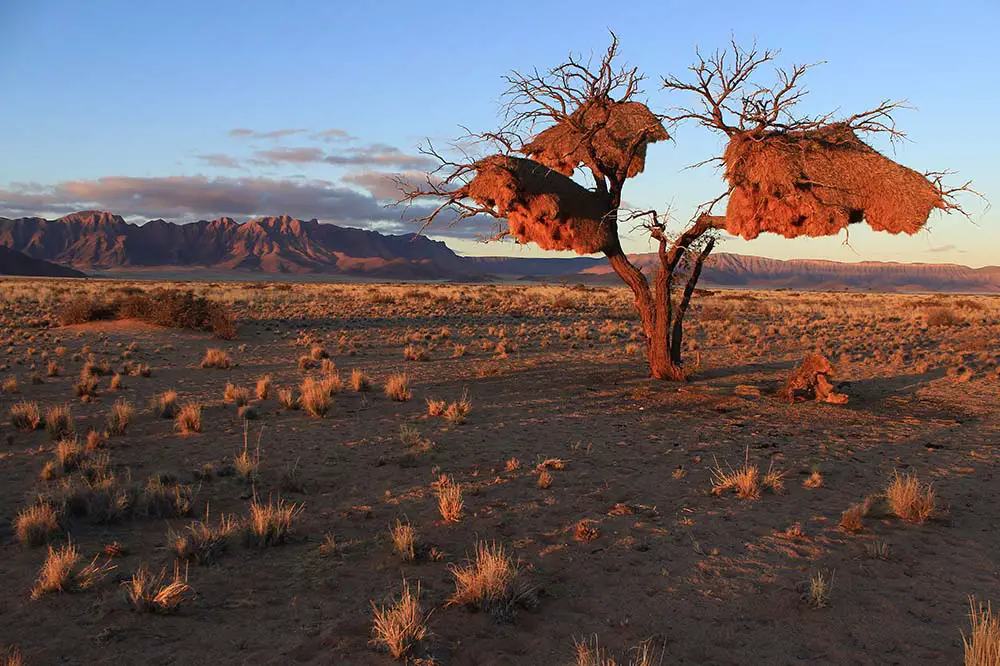
The only other nest I could find that is even remotely similar is that of the monk parakeet, which is a member of the parrot family and the only species to nest colonially. These large stick nests usually contain around 20 chambers and like those of the sociable weaver are most often built in trees but are not uncommonly found on utility poles.
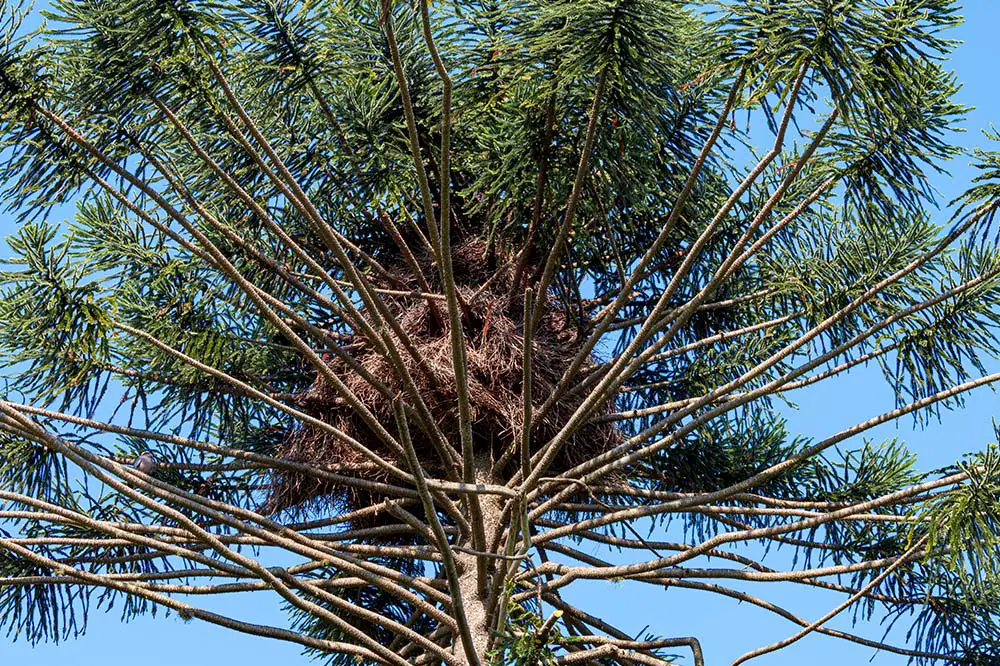
Cavity
The term cavity nest refers both to holes excavated by their inhabitants and existing cavities used for nesting. Some of the most common locations for cavity nests include trees, cacti and rocks. The inside of these nests is lined with soft materials such as mosses and feathers.
The first cavity nest we’ll look at is that of the resplendent quetzal. These spectacular birds don’t possess beaks strong enough to excavate their own holes so both sexes pitch in to continue abandoned cavities made by woodpeckers in rotted tree trunks. This behaviour makes them secondary cavity nesters.

Woodpeckers, who bore their own cavities over multiple weeks, are referred to as primary cavity nesters and not only drill their holes into trees but cati as well. The Gila woodpecker is found in the Sonoran desert and often uses the Saguaro cactus as its nesting site. Holes are excavated by both males and females and are reused by the elf owl.
The most unique cavity nester I could find is the Lear’s or indigo macaw which are found only in eastern Brazil and use natural cavities in the area’s sandstone cliffs to make their homes.

Platform
Platform nests are the last elevated nest type we’ll cover before moving to the ground. They are large structures made from sticks and twigs and are typically flat with a saucer-shaped surface.
Some of the easiest to observe, at least in Afro-Eurasia, are those of the white stork which can be seen on the tops of buildings or utility poles. Nests, which can measure 6.5 ft (2 m) wide and 10 ft (3 m) deep, are built by males and are often reused for multiple years.
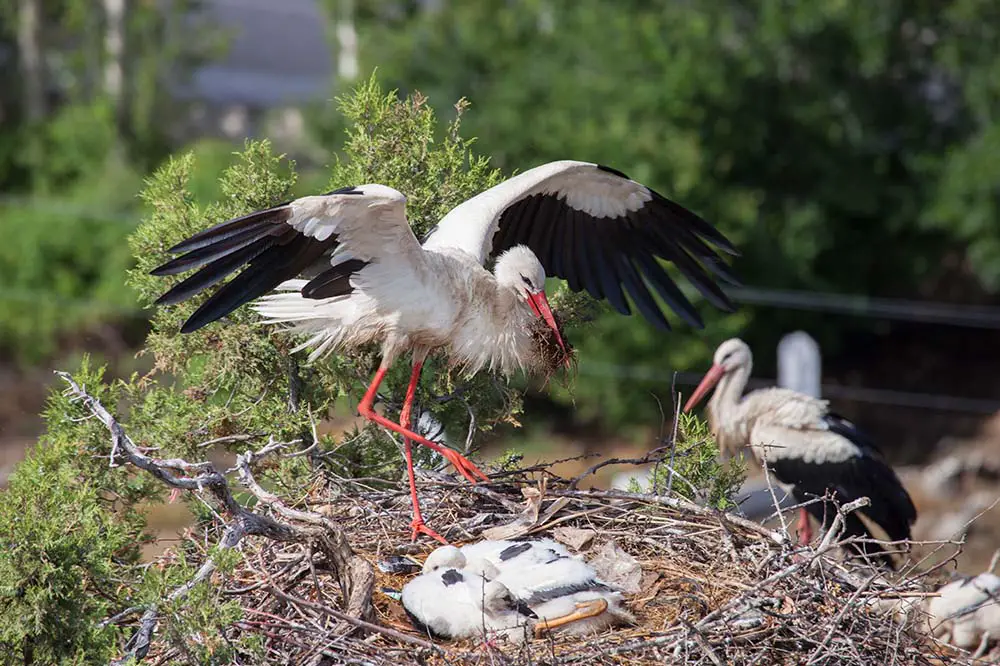
In the Americas, great blue herons usually build their platforms in trees, which can take up to 2 weeks to construct. With this species, it is the male who collects the material and the female who weaves the nest, lining it with soft materials such as moss and dried grass.
Platform nests are also popular with raptors such as ospreys and eagles for whom they are referred to, specifically, as aeries. Golden eagles build theirs on the side of cliffs with spectacular views of the surrounding forest. Nests are lined with mosses, lichens and conifer branches and can be used year-round by resident birds.

Floating
Floating nests are another interesting category, which are very similar to platforms but instead of being built high in the trees, they rest in the shallows of waterways.
One of the best examples of a floating nest are those of the great crested grebe, which are built by both the male and female. They are made out of aquatic plant matter such as waterweed and only take a few hours to build. Grebe nests are usually positioned in the shallows of lakes or reservoirs just out of reach of terrestrial predators.

Swans are also aquatic nest builders and while some pairs build their nests on land, most are assembled a few feet from the shore in shallow, calm water. Construction is also shared by the pair with males collecting the material while the female does the crafting. Nests are built from aquatic vegetation such as bulrushes and reeds as well as twigs and sticks.

Burrow
Moving to the shore, the first of our terrestrial nest types is another form of cavity but is excavated from soil and classed instead as a burrow
The burrowing owl will either create a burrow itself or use those of ground squirrels, prairie dogs or other burrowing animals. Interestingly, these kinds of burrows are also used by rattlesnakes, the sound of which the owls mimic to ward off predators, a tactic known as acoustic Batesian mimicry.
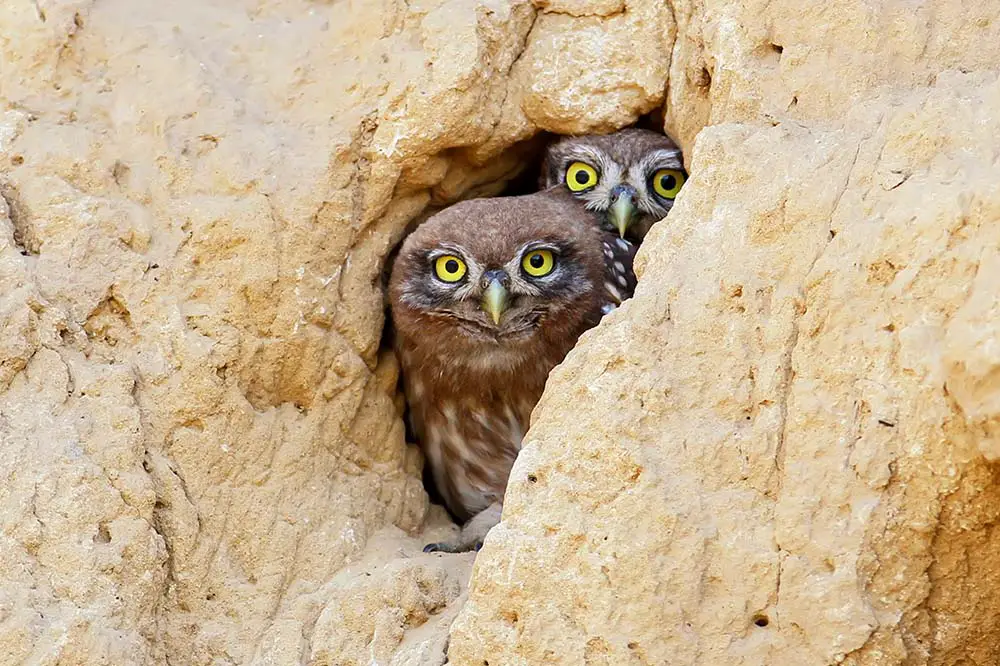
Puffins are other birds who excavate their nests from soil. This responsibility is shared between the male and female and once dug, burrows are lined with grass and twigs. These birds spend the winter on the ocean and will often return to the same nest the following year.
Not all burrow nests are found in the ground. Bee eaters are highly sociable birds and excavate their burrows in the side of sandbanks. Nests take up to 3 weeks to build and consist of a tunnel, which can be over 3 ft (1 m) long and culminates in an unlined nesting chamber. Colonies of these beautiful birds can number as many as 1000.

Mound
Another nest type related to soil is the mound nest. There are several types of mound that we’ll split into 2 different categories. The first are simple structures built from mud and serve to raise the egg or young off the floor, keeping it clean and safe.
Mudflats are a popular habitat for flamingos who use the abundant supply of mouldable mud to build their nests. Males begin work on the nest, which is finished by both birds and will stand approximately 12 in (30.5 cm) once complete. The upper surface is saucer-shaped to house the egg and their young once hatched.

Another bird that utilises the mound nest is the albatross, specifically the black-browed albatross. These birds are monogamous and breed in colonies on cliffs overlooking the ocean. The shape and structure of these nests is almost the exact same as that of a flamingo.
The wandering albatross also uses mound nests, although breeding takes place on subantarctic islands where peat is the dominant soil type and their mounds appear to be much softer.

Self-incubating
The birds of the Megapodiidae family are known as megapodes or incubator birds. Their nests are also referred to as mounds but look and function in a completely different manner to those previously discussed so I’ve categorised them separately.
The construction of the mallee fowl nest is done mostly by the male who creates a ginormous mound of sandy soil over a period of many months that can measure 13 ft (4m) wide and 3 ft (1 m) high. The female then lays the egg into a cavity dug into the top of the mound, which is covered with vegetation and topped with a final layer of sand. The vegetation generates heat as it decomposes, incubating the eggs.
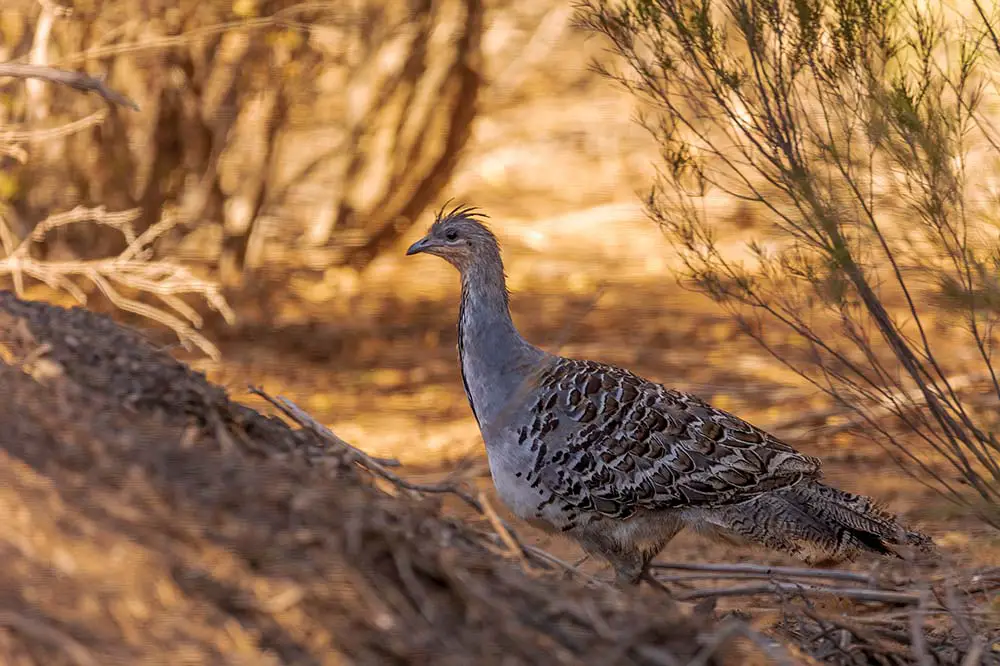
Maleo use only sand to construct their nests, which are really more of a hole than a mound. Males dig the hole into which the female then lays the egg. The pair then bury it and, like mallee fowl, never return. The hot sand incubates the egg and the precocial chick emerges entirely self-sufficient, complete with the ability to feed itself and fly!
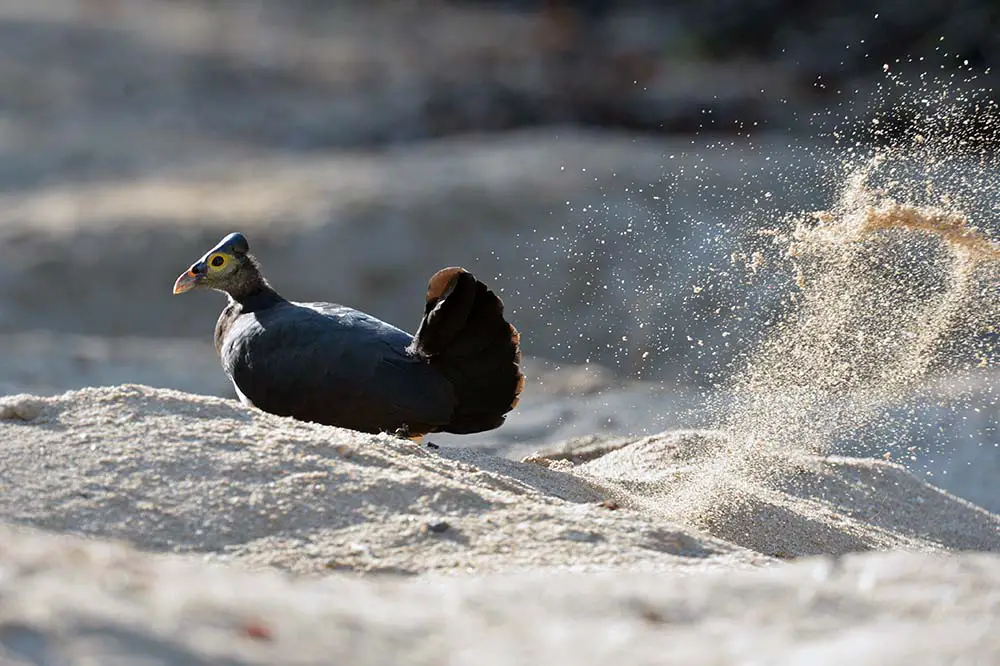
Scrape
Not all nests are as elaborate as the ones covered so far. A scrape nest is pretty much exactly as it sounds; birds will scratch a depression in the ground with their feet where they lay their eggs and nurture their young.
The common ringed plover nests on the rocky beaches of Northern Eurasia and Greenland. Females make a shallow scrape, which is lined with pebbles and vegetation. Considering predation, these nests are vulnerable so both the adults, eggs and chicks are well camouflaged for this environment, making them harder to detect.
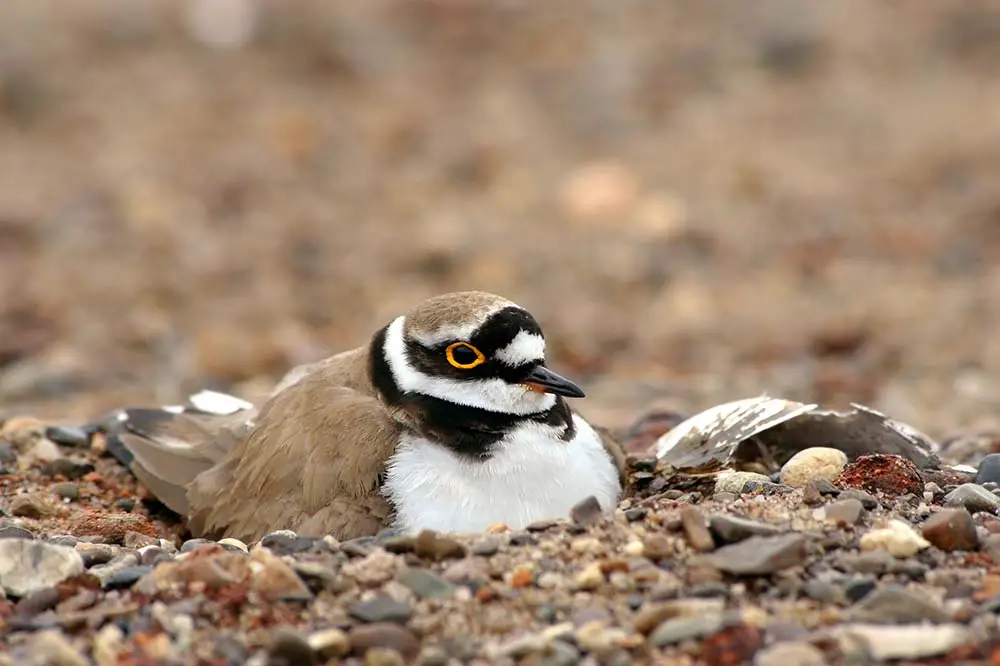
The peregrine falcon is another bird that creates a shallow depression for its eggs, which are often positioned on ledges and sometimes have a light lining of vegetation. Males will create multiple scrapes for the female to choose from before she decides on the final nesting location.
Gentoo penguins have slightly more substantial scrapes than the other species we’ve discussed. They will often pile up stones and other materials to the point where some of these nests could be considered a mound rather than a simple scrape.

No Nest
Finally, there are a few birds for whom a nest is not necessary whatsoever.
One of the best examples is king penguins who live in huge colonies of almost 40,000 breeding pairs and build no nest at all. Once the female has laid the egg it is passed on to the male who positions the egg on his feet and incubates it using a brood pouch, which amounts to a patch of bare skin on their bellies. Once the egg is hatched, the parents take turns incubating the chick until spring when the weather is warmer and the chick can survive on its own. This behaviour is shared by only one other penguin species, the emperor penguin which holds the Guinness world record for the longest egg incubation for a penguin at 67 days.
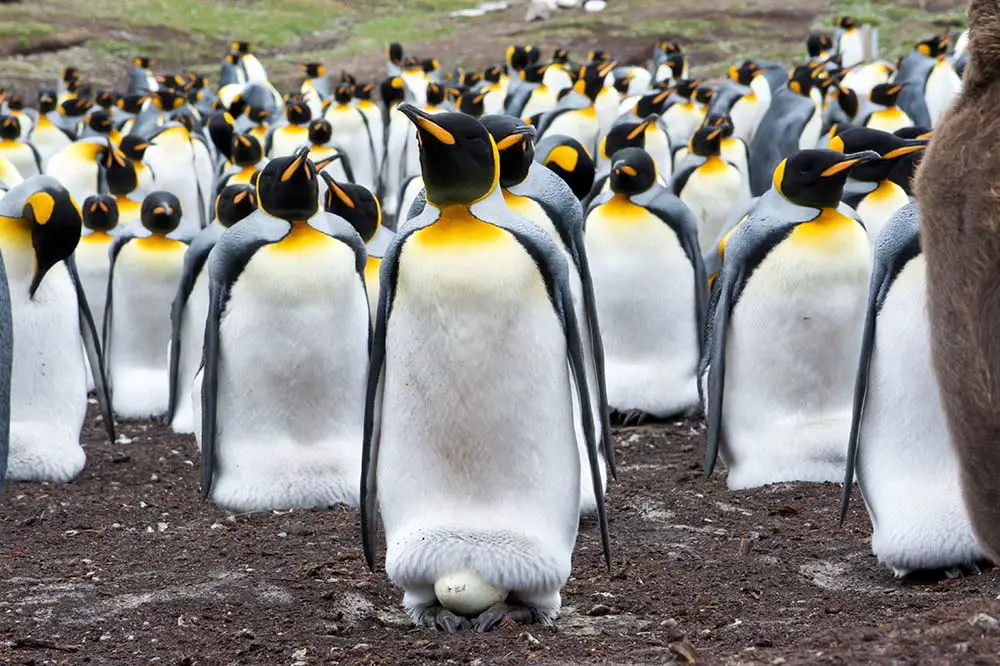

Left: King penguin with egg / Shutterstock & Right: King penguin with young chick / Shutterstock
Honourable Mention
The last structure we’ll look at is visually very similar to many of those we’ve covered so far but I discovered is not actually a nest. The male bowerbird builds an intricately decorated display known as a bower to attract females. This consists of a woven structure, which varies by species and is decorated with colourful items, which can include both organic material and things like bottle caps and straws. Upon choosing her mate, the female will build the actual nest where she lays her eggs.

Sources
Bird Nest Identification, All About Birds, Wikipedia, Types of Bird Nest, Types of Bird Nests, How to Spot Bird Nests, Bird Nests, Nest Type Identification, Beautiful Bird Nests, Remarkable Bird Nests, Unusual Bird Nests, Nidifugous vs Nidicolous, Altricial vs Precocial, White Stork, Eagle Facts, Edible Nest Swiftlet, Barn Swallow, Dome Nests, White Throated Dipper, Hamerkop Nests, Montezuma Oropendolas, Study on Nest Construction, Sociable Weavers, Analysis of Nest Sites, Resplendent Quetzals, Macaw Breeding, Carmine Bee Eater, Wandering Albatross, Maleo Nests, Malleefowl, Largest Bird Nests, Common Ringed Plover, Penguin Architecture, Falcon Scrape, King Penguin, Longest Egg Incubation, Swan Nests, Great Crested Grebe & Bowerbird.


